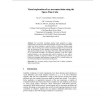Free Online Productivity Tools
i2Speak
i2Symbol
i2OCR
iTex2Img
iWeb2Print
iWeb2Shot
i2Type
iPdf2Split
iPdf2Merge
i2Bopomofo
i2Arabic
i2Style
i2Image
i2PDF
iLatex2Rtf
Sci2ools
GISCIENCE
2010
Springer
2010
Springer
Visual Exploration of Eye Movement Data Using the Space-Time-Cube
Abstract. Eye movement recordings produce large quantities of spatiotemporal data, and are more and more frequently used as an aid to gain further insight into human thinking in usability studies in GIScience domain among others. After reviewing some common visualization methods for eye movement data, the limitations of these methods are discussed. This paper proposes an approach that enables the use of the Space-Time-Cube (STC) for representation of eye movement recordings. Via interactive functions in the STC, spatiotemporal patterns in eye movement data could be analyzed. A case study is presented according to proposed solutions for eye movement data analysis. Finally, the advantages and limitations of using the STC to visually analyze eye movement recordings are summarized and discussed.
| Added | 09 Nov 2010 |
| Updated | 09 Nov 2010 |
| Type | Conference |
| Year | 2010 |
| Where | GISCIENCE |
| Authors | Xia Li, Arzu Çöltekin, Menno-Jan Kraak |
Comments (0)

